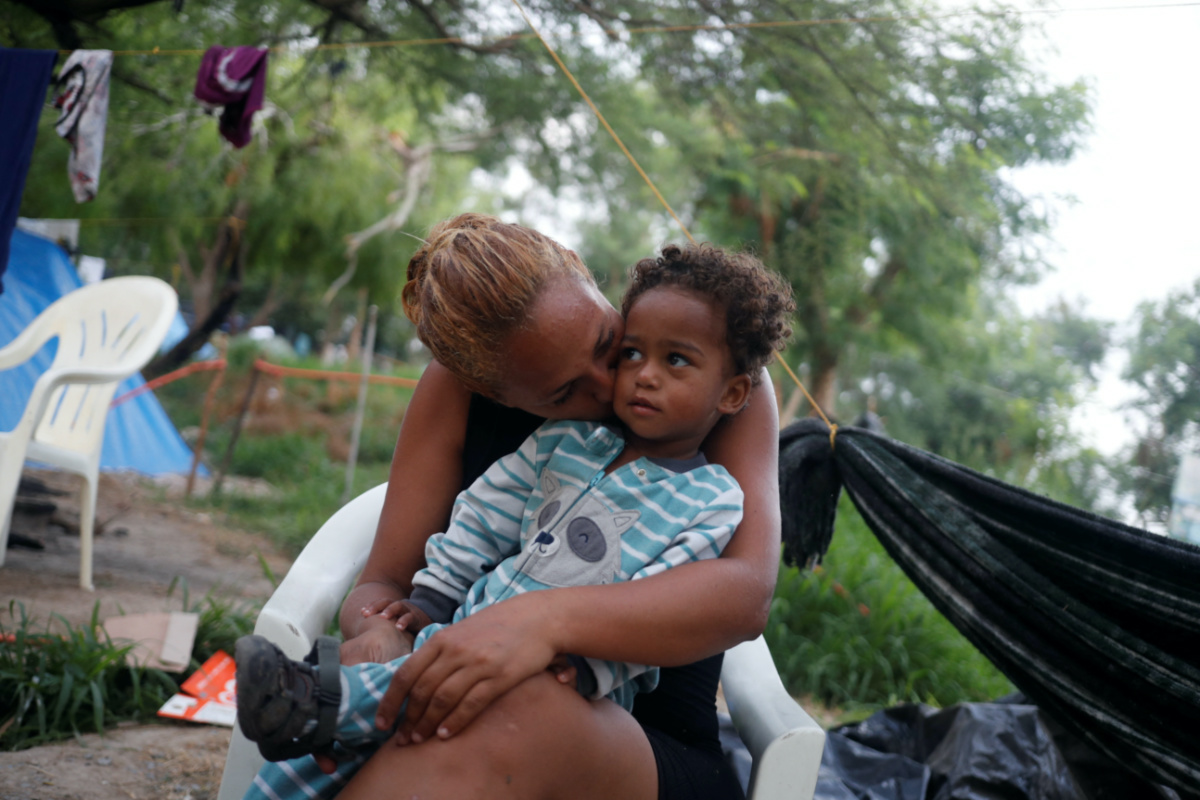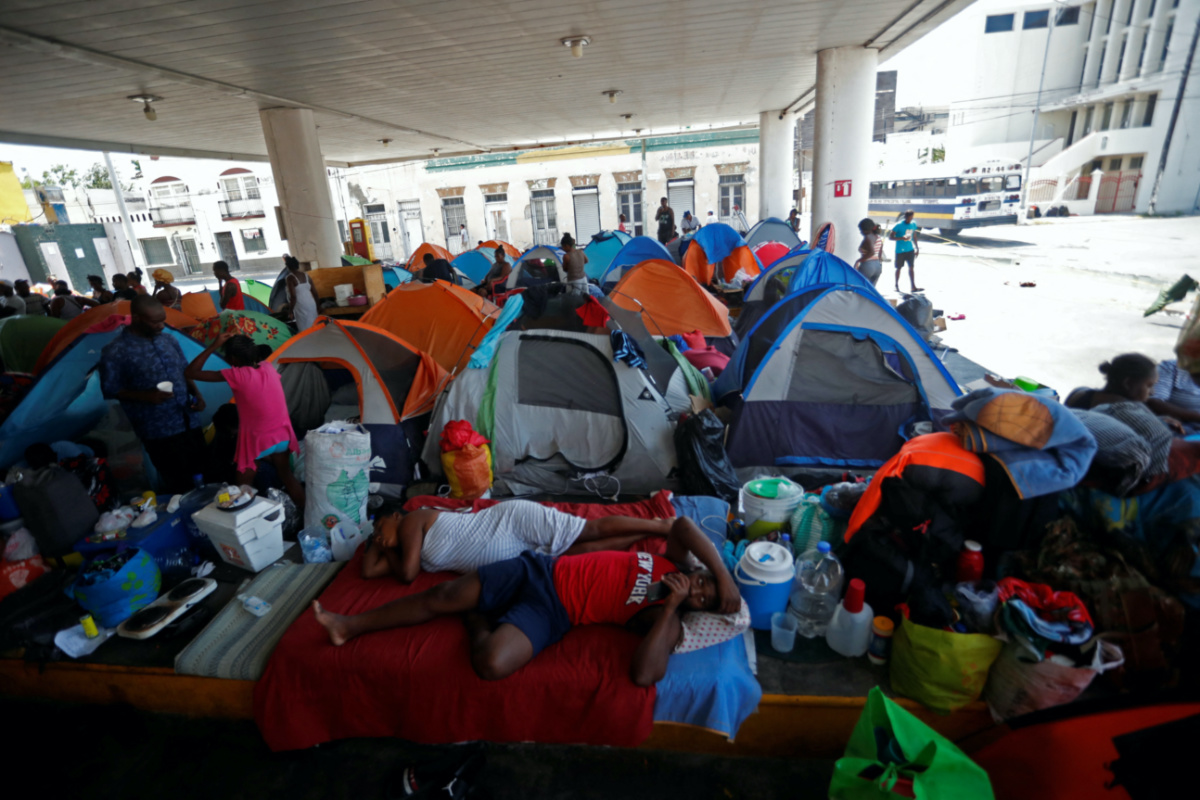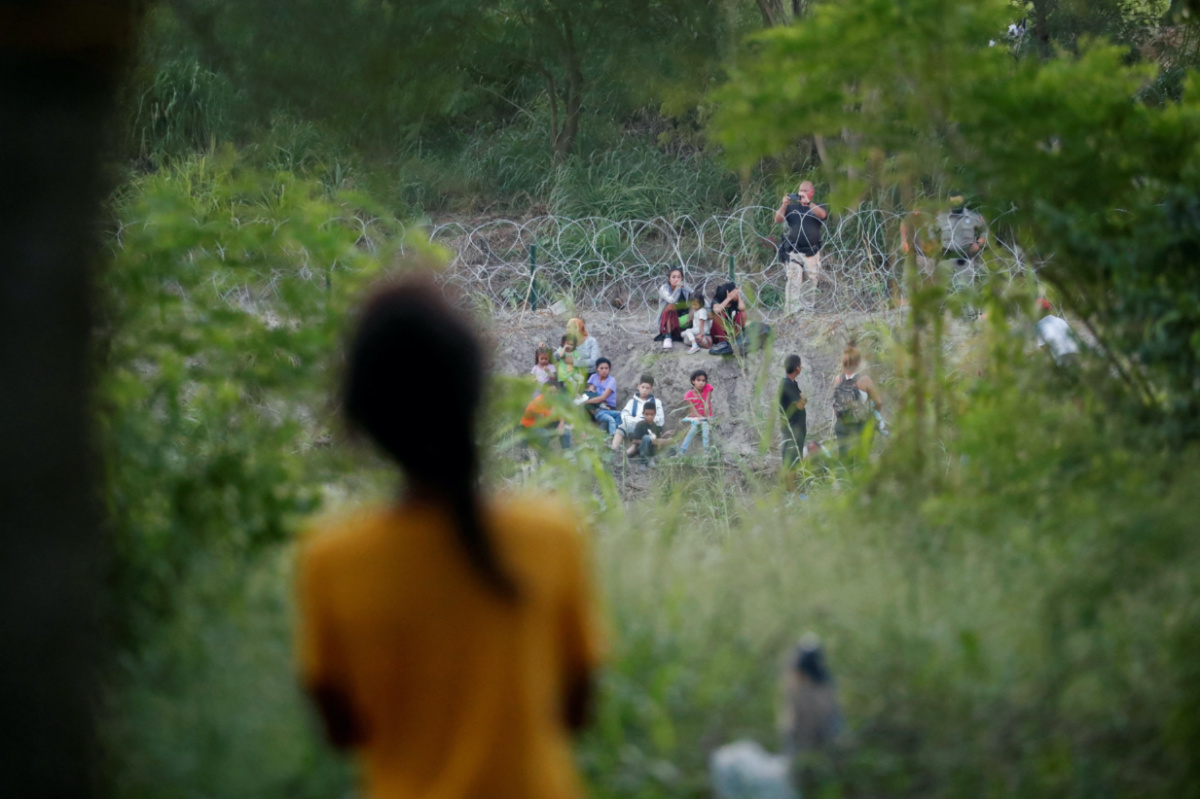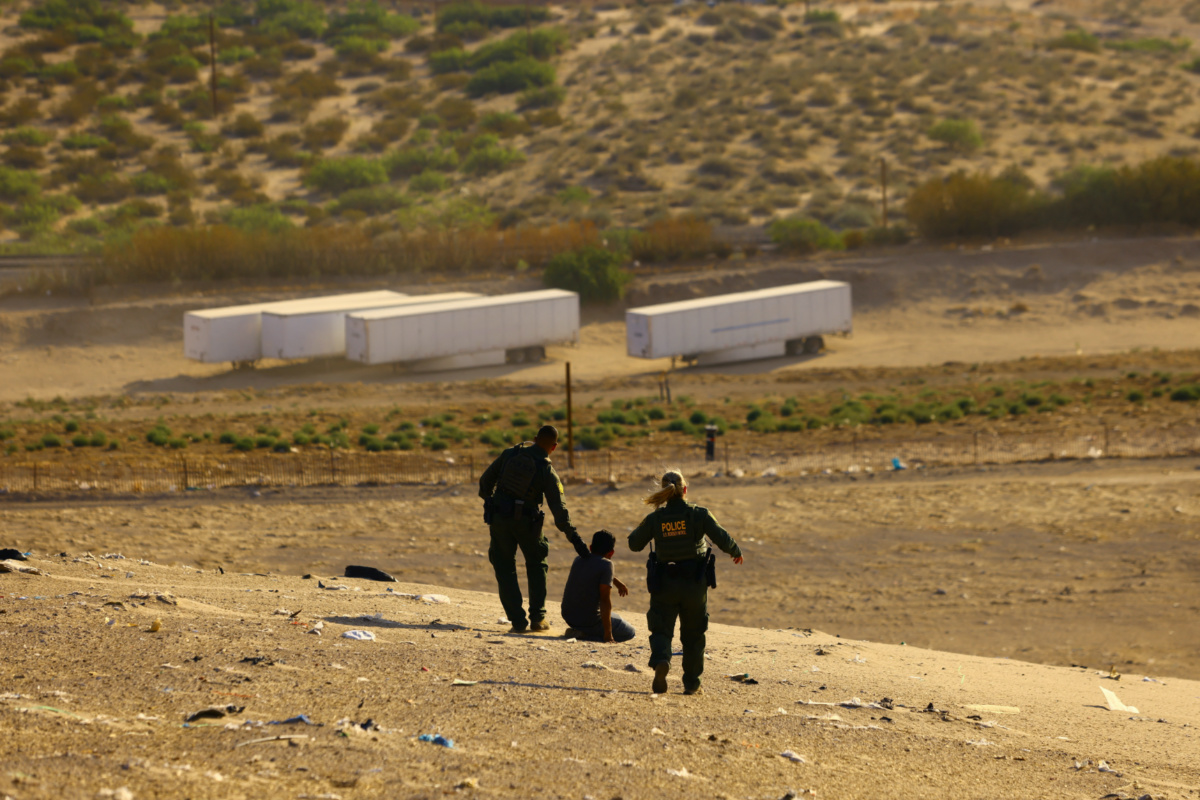
LAURA GOTTESDIENER, TED HESSON, MICA ROSENBERG, KRISTINA COOKE and DAINA BETH SOLOMON, of Reuters, report…
Matamoros, Mexico
Reuters
On a June afternoon when temperatures climbed near 38 degrees Celsius, Alejandra Pena gently tipped a jug of water into her son’s mouth. Like other children in the migrant camp, a mile-long stretch of tents along the banks of the river separating Mexico from the United States, the toddler had diarrhea. Pena worried the boy was dehydrated.
“Drink, Natanael. Drink,” Pena coaxed. One of the few humanitarian groups operating in the camp had told her Natanael was malnourished and underweight, she said, attributing his condition to the lack of clean water and poor sanitation in the camp.

A migrant sits in a Border Patrol vehicle after being apprehended crossing the US-Mexico border in the desert of Sunland Park, New Mexico, US, on 23rd June, 2023. PICTURE: Reuters/Jose Luis Gonzalez
Pena, 34, fled Venezuela after a criminal group killed her sister, according to interviews and police records. Hoping to seek asylum in the United States, she said her family was stuck in northern Mexico because of new US border rules adopted on 11th May by the administration of President Joe Biden.
The rule requires migrants to make an appointment on a government-run smartphone app before approaching the border – but none of the people with Pena has a device.
“We are paralysed here.”
Alejandra Pena, who fled Venezuela after a criminal group killed her sister and is now stuck in northern Mexico.
“We are paralysed here,” Pena said.
Biden, a Democrat, promised to replace the hardline policies of Republican President Donald Trump, including the COVID-era public health order Title 42, with a more humane immigration system.
Title 42 allowed border agents to expel migrants to Mexico without a chance to seek asylum. The new Biden regulation allows migrants once again to ask for asylum at the border, but wait in Mexico for a slot on the app or risk a sped-up deportation process that could be conducted while they are held in detention.
Officials said the regulation and other Biden immigration policies are reducing illegal border crossings that have hit record highs in recent years.
But in the first month of the new policy, Reuters interviews with more than 50 migrants, US and Mexican officials, a review of court records and previously unreported data found:
• Tens of thousands of people waiting in dangerous Mexican border towns to snag a spot on the app, according to US and Mexican officials, and warnings from humanitarian groups of deteriorating sanitary conditions at migrant camps;
• A sharp drop in people passing their initial US Citizenship and Immigration Services (USCIS) asylum screenings, down to 46 per cent for single adults from an average of 83 per cent from 2014 to 2019, according to government data contained in a court filing;
• A 35 per cent increase in people detained by US Immigration and Customs Enforcement (ICE), the filing said;
• A sharp rise in time spent in Border Patrol custody, according to previously unreported US Government data obtained by Reuters; and,
• Roughly 50,000 people deported, according to the court filing.

Haitian asylum seekers set up camp in an abandoned gas station while they wait to attempt to cross into the US by an appointment through the Customs and Border Protection app, called CBP One, at a makeshift camp, in Matamoros, Mexico, on 21st June, 2023. PICTURE: Reuters/Daniel Becerril
Migrants who don’t use the Customs and Border Protection app, called CBP One, face a higher bar to claim asylum if they passed through another country without seeking refuge there, a standard which critics say mirrors a Trump policy that was blocked by courts. Those who fail the screening can be deported and banned from entering the US for five years.
A senior Biden administration official told Reuters the policy was working. Government figures show the number of migrants caught crossing illegally has dropped by 69 per cent in one month.
“Our goal is to incentivise people to go through legal channels,” said the official, who was granted anonymity as a condition of the interview. “We’re seeing, so far, initial positive results.”
The US on 30th June increased the number of appointments available on the app to 1,450 a day from 1,250.
Pena said she wants to follow the rules. But her partner’s phone was stolen in Colombia; the kids’ tablet was sold in Costa Rica and they lost their last smart device in a robbery in Guatemala. Pena hopes to buy a smartphone but the family has so little money that they are begging on the street just to eat, she said.
The Biden official said the administration is working with shelters and other non-governmental organisations to expand internet access for migrants, adding that there was no need for them to wait in dangerous border towns: “There are plenty of safer parts of Mexico where people can go.”
Juan Rodriguez, head of the state-level migrant services agency, said officials visit the Matamoros camp a few times a month to provide water and health services.
But he said he was worried that the CBP One app left some migrants waiting. He said even more spots would help.
“That would allow us to control the flow [of people] in a more normal way so that it doesn’t overwhelm us,” he said.
The Mexican Federal Government did not respond to requests for comments on the camp conditions or the regulations.
By mid-June, the population of the Matamoros camp exceeded 5,000, according to Rodriguez, with an additional 3,000 migrants scattered across Matamoros in shelters, hotels, Airbnbs, abandoned houses, and an out-of-service gas station, local officials said.
The camp, formed during the Trump presidency, became a Democratic talking point during the 2020 elections. JoeBiden denounced policies that left people in “squalor on the other side of the river.” Jill Biden, on a 2019 tour, tweeted: “This cruelty is not who we are.”
Humanitarian organizations say at times the camp has grown bigger under Biden than during the Trump years.
“We’re trying to provide food and water, but it’s insufficient. We’re overwhelmed,” said Glady Canas, head of a local nonprofit that helps migrants in the Matamoros camp.
Approximately 104,000 migrants are amassed in northern Mexico overall, according to US government figures.

Venezuelan asylum seeker Nathaly, 13, observes a group of migrants being turned back to Mexico by US border patrol agents, while she and her family wait to attempt to cross into the US by an appointment through the Customs and Border Protection app, called CBP One, at a makeshift camp, in Matamoros, Mexico, on 21st June, 2023. PICTURE: Reuters/Daniel Becerril
As mosquitos descended at dusk, Pena doused her children in the last of their bug spray. Swollen red bites pockmarked Natanael’s face and the bodies of his sisters Nathalya, 11, and Nathaly, 13. Doctors Without Borders (MSF) said they have seen a few suspected cases of malaria and dengue fever.
Nightfall also brings out criminal groups, camp residents say.
Crime in the camp pre-dates Biden’s presidency, but the threat of the five-year ban makes some people fearful of crossing the border to escape, advocates said.
Cindy, a 23-year-old from Honduras, hesitated for weeks to approach the US border, even after she was raped repeatedly in the Matamoros camp and in a house nearby by men she believed to be part of a cartel, she told Reuters.
Cindy, who Reuters is identifying only by her first name due to the nature of the attacks, said the men threatened to “disappear” her three-year-old son if she reported the assaults to Mexican authorities, according to interviews and a written report from the psychiatrist who evaluated and accounts from her attorney.
Desperate after multiple assaults, and unable to secure an appointment on the CBP One app, she and her son walked up to the international bridge on 21st May. She said they were allowed to enter and given a notice to appear in immigration court in Houston in August.
Officials and advocates said families are subject to the higher asylum standard, but have not been held for in-custody screenings; while Cindy was not detained she may still have a tougher time winning her case in immigration court.
The Mexican state-level security agency did not respond to request for comment about violence in the camp. The Biden administration did not respond to questions about Cindy’s case.
The Biden border strategy set a target of 63,000 sped-up screenings for the month of June, more than five times the previous high in July, 2019, according to a previously unreported virtual town hall for USCIS officers which was shared with Reuters.
Asylum division chief John Lafferty told the town hall that the administration aims to process migrants for release or deportation within one or two weeks and cut the time migrants have to consult with a lawyer from 48 hours to 24 hours.
“Like it or not, we are an immigration consequence,” Lafferty said. “We are part of the enforcement strategy that has been pursued by the department and the administration in the post-Title 42 era.”
Some asylum officers in the meeting raised concerns about the timelines.
“We are hearing that when an applicant calls an attorney but no one answers, supervisors are determining that is considered sufficient opportunity to seek representation and the interview must proceed,” one officer who was not identified by the moderator said.

A migrant sits in a Border Patrol vehicle after being apprehended crossing the US-Mexico border in the desert of Sunland Park, New Mexico, US, on 23rd June, 2023. PICTURE: Reuters/Jose Luis Gonzalez
In a 7th June filing supporting a lawsuit brought against the regulation by the American Civil Liberties Union and others in US District Court in northern California, the union representing asylum officers said the policy puts “our international and moral commitments at risk.”
Biden’s rule was as harmful as Trump’s, the ACLU argued, adding: “It will effectively eliminate asylum for nearly all non-Mexican asylum seekers who enter between designated ports of entry, and even for those who present at a port without first securing an appointment.”
The government responded in legal filings that the rule was a “well-reasoned border management policy that for the past month and a half has been key to ensuring the continued functioning of the US immigration and asylum system during exigent circumstances while providing ways for vulnerable populations to seek protection.”
A spokesperson for the US Department of Homeland Security, which oversees USCIS, told Reuters that the regulation will reduce the strain on immigration courts by swiftly denying asylum claims with no merit. Lafferty did not respond to a request for comment.
We rely on our readers to fund Sight's work - become a financial supporter today!
For more information, head to our Subscriber's page.
When Jose Miguel Anariba, 37, fled gang threats in Honduras with his wife and three daughters, along with his wife’s two sisters and their families, he said he thought his best chance at avoiding expulsion was to enter the United States undetected by himself and earn enough to pay smugglers to help his family do the same.
He waded across the Rio Grande into Eagle Pass, Texas, on 13th May, according to ICE records, two days after Title 42 ended and expulsions were no longer in place. He was taken into custody and told that he could make an asylum claim while in detention. But under the new rules, he would face a higher bar because he crossed illegally and passed through other countries without seeking refuge there.
On 24th May, Anariba had a phone interview with an asylum officer through an interpreter, according to interviews with Anariba in detention, his attorney and case documents.
He said he tried to tell the officer his family had been targeted by gang members because of the work he did with his brother-in-law, a youth pastor who had led several protests against gang murders. The threats persisted after his brother-in-law fled and won US asylum in 2019, according to the documents.
When Anariba tried to tell the family’s story, he said the officer cut him off, reminding him to speak only about himself. “Is there anything that prevented you from seeking out a lawful pathway to the US?” asked the interviewer. “I do not understand the question,” Anariba answered.
He was denied. On 6th June, ICE records show he appealed to an immigration judge – again over the phone through an interpreter. Neither Anariba nor his lawyer Lisa Knox were given transcripts of his interview in time to prepare for his hearing due to the fast pace of the process, they said.
His appeal was denied.
Knox filed a request for reconsideration with almost 100 pages of additional evidence, including photos of the aftermath of a gang attack on Anariba’s house.
Again, denied.
USCIS said it could not comment on individual cases. ICE said it operates on a “case-by-case basis, in accordance with US law.”

US Border Patrol agents Sean Coffey and Marcia Finnegan apprehend a migrant who attempted to cross the US-Mexico border without detection, near Mount Cristo Rey in Sunland Park, New Mexico, US, on 23rd June, 2023. PICTURE: Reuters/Jose Luis Gonzalez
Meanwhile, Anariba’s wife Elsa and their daughters 10, 12, and 14, surrendered at a US border crossing on 30th May.
After a couple days in custody, they were released and told to check in with ICE, according to documents shared with Reuters. They are living in Houston pending a court date for their asylum hearing.
A few days ago, Elsa said, she got a call from Anariba. He told her he had been deported.
– Additional reporting by LIZBETH DIAZ in Mexico City, Mexico, and GUSTAVO PALENCIA in Tegucigalpa, Honduras






